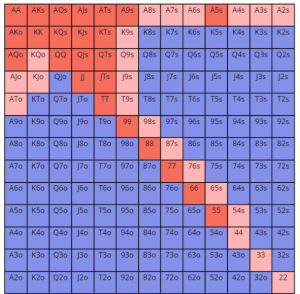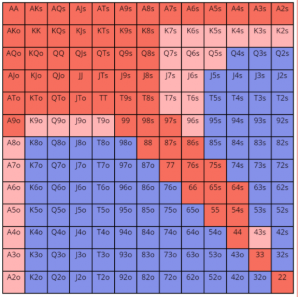If you open from all positions with the same range as when there is no ante, you are making a mistake that costs you money.
Most players waste chips by failing to adjust their pre-flop range when trying to win dead money. When there is an ante in the game, the pot collected before the flop is about 40% larger than when playing without an ante. This means that with an ante, we need to play much wider than we do without it.
This time we will discuss a few examples that will reveal how our opening range should change in early, middle, and late positions with and without an ante.
Do not take the provided ranges as an indisputable rule; they are just guidelines to help you develop your pre-flop strategy.
Ante vs. No Ante. Mathematics
If we play with a standard-sized ante and open to 2.25BB, we need to win the pot at least half the time for this opening to be profitable.
To ensure that we need to open wider when there is an ante, let's look at an example:
At a table with 9 players. Blinds 250/500/50.
The hero in the BU position gets two cards, and everyone folds to him. The hero opens to 1125.
Before the raise, the pot was 1200 with blinds and antes (250+500+450), and the hero risks only 1125 chips by opening. To profit, our opening needs to succeed (everyone folds) 48.4% of the time. And this calculation does not include cases when we win the pot after the flop.
If there were no ante, the pot would be 750 chips, in which case, to profit, our opening needs to be successful 60% of the time. This 10.6% difference makes a significant impact, requiring us to adjust our pre-flop opening strategy.
Now let's pay attention to specific ranges.
Note:
These ranges are adapted for low-mid stakes online games and standard live tournaments. However, they do not consider specific different situations that may arise (a specific player behind you who is in the BB position, etc.). The examples are selected for ranges when players have 30BB or more.
Example range when you are in early positions: UTG+1
Let's start with how our range changes in early positions.
From the UTG+1 position, we open about 10% when there is no ante. This is a very narrow range but very important. This range is similar to the range in cash games, where antes are very rare.

Red – raise
Blue – fold
When an ante is introduced in the game, we can almost double our opening range to about 20% of hands. We can open all suited aces, all pairs, some suited connectors, and off-suit broadway cards.

Red – raise
Blue – fold
Pink – raise when there is an ante
Example range when you are in middle positions: LJ
From the LJ position, we open about 16% of hands when there is no ante.

Red – raise
Blue – fold
When an ante is introduced, we can profitably open up to 28% of hands. All broadway cards and many suited connectors with gaps (e.g., T7s). Here is an example of a reasonable range:

Red – raise
Blue – fold
Pink – raise when there is an ante
Example range when you are in late positions: CO
Finally, an acceptable opening range from CO when there is no ante (26% of hands):

Red – raise
Blue – fold
Now let's look at an example range from CO when playing with an ante:

Red – raise
Blue – fold
Pink – raise when there is an ante
Adjust your range using the information you have
Again, these range recommendations are made without considering the specific players you are playing against. Here are two questions you need to answer for yourself before opening:
- What kind of players are behind you?
If there are strong, aggressive, regular players behind you, you need to adjust and narrow your range. Strong players will be the first to realize that you are opening too wide and will often respond with 3-bets.
On the other hand, if there are weak and passive players behind you, you can widen your opening range without worrying about facing 3-bets.
- What kind of player is in the BB position?
If the opponent in the BB position is weak and passive, widen your opening range and take advantage of the fact that he will fold more often than he should. Against a weaker but aggressive opponent, narrow your range and consider increasing your opening size to give him less favorable pot odds.
To summarize
So, use different ranges when playing without an ante and with one, as this factor makes a significant difference. Also, don't be a nit when an ante is introduced in the game; fight and take the dead money.
Translated from https://www.upswingpoker.com/poker-antes-tournament-raising-strategy/





